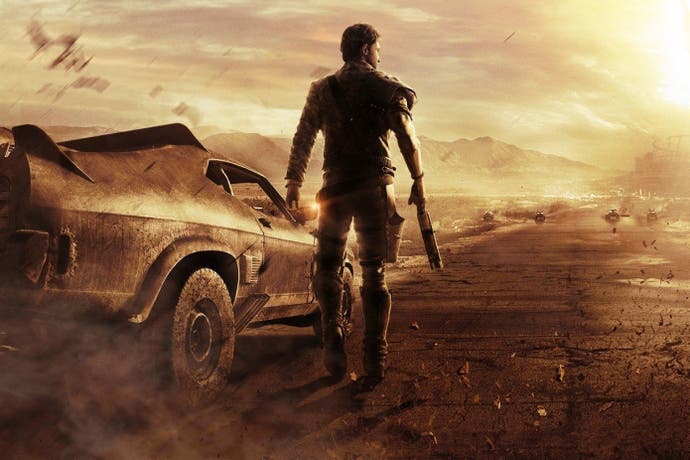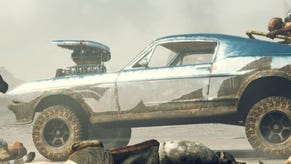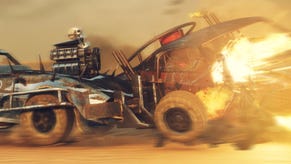Mad Max review
Fast and Furiosa.
There have been wastelands before, of course. From the Darling brothers' The Last V8 through to Fallout 4, the dust and decay of a post-apocalyptic world have long been one of video games' playgrounds of choice, where the sandboxes are dotted with discarded car wrecks and burnt-out petrol stations. How strange and satisfying it is, then, to return to one of the original wastelands, as birthed in George Miller's edgy cult 1979 film Mad Max before being fully explored in 1981's excellent sequel The Road Warrior.
Warner Bros' open-world action take on Mad Max isn't directly linked to any film in particular, even if it takes many of its cues from the recent Fury Road. Like its filmic inspiration, its premise is brutal in its simplicity: you're Max Rockatansky, a drifter in the wasteland, and after being pounced upon by Scabrous Scrotus, son of Fury Road's wild-eyed villain Immortan Joe, you're left without your legendary Interceptor car. And so it's up to you and new acquaintance Chumbucket, a deformed, lisping mechanic, to reclaim what's rightfully yours and to build a new set of wheels for yourself in the process. What we're left with is the curious, enjoyable wreckage that comes after a head-on collision between My Summer Car and a post-apocalyptic Assassin's Creed.
Like Middle-earth: Shadow of Mordor and the latter Batman: Arkham games, Mad Max sees Warner Bros funnelling its cinematic property through the open-world template as established by Ubisoft's catalogue: a vast, hostile map being slowly conquered through the capture of camps and the destruction of watch towers. Hot air balloons take the place of Assassin's Creed's viewpoints, the wide vista you acquire marking out hotspots in each region, while Strongholds can be reinforced and fitted with supply units that help keep you stocked up as you work your way through the wastelands to your final mark. In the creeks and crevices of the plains of silence, there's endless busywork to be found.
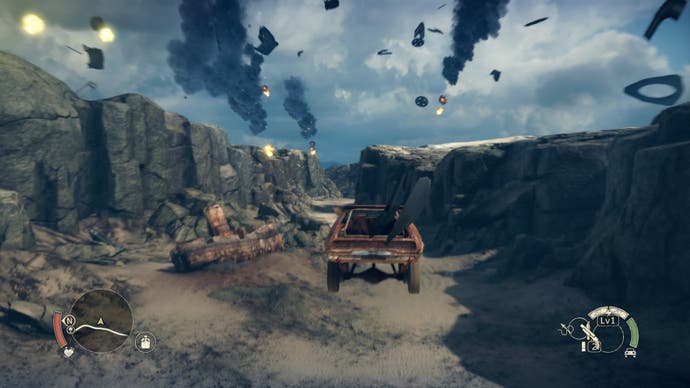
Max is the perfect cipher for the tangle of objectives that is the contemporary open-world game, an aimless nomad who floats through people's lives and is now fuelled by something more urgent than seeking revenge for the loss of his wife and child: who's got the keys to his goddamn car? He's more vocal here than we've become accustomed to (and voice actor Bren Foster, as you might expect from someone with a handful episodes of Home & Away on his IMDB page, does a more convincing Australian accent than Tom Hardy mustered in Fury Road), yet there remains something thrillingly primitive about his quest. In your travels across the wasteland you'll often see Gas Town, the neon-encrusted, flame-spitting fort where Scrotus is holed up, bubbling away on the horizon, always keeping your objective in focus.
Where developer Avalanche Studios has triumphed with Mad Max is in weaving together Miller's cinematic universe and the modern open-world video game with a real sense of purpose. There's a barbarity to the wasteland that's reflected in the systems and in Max himself. Resources are scarce, be it the dog food and maggots you'll stumble across to top up your health, the water you can carry around in a can to take big, thirsty glugs out of, or the scrap that's required to unlock upgrades for Max and his car. Likewise, ammo is hard to come by: Max only ever has a shotgun by his side, and it's rare to have more than one or two shells to take into a fight against a dozen or so enemies.
When using Max's fists, combat that feels outwardly familiar carries a certain clumsiness. The fluid pugilism of Rocksteady's Batman has been appropriated, but the balletic grace has been left back in Gotham; here it's more a flurry that can get lost in lurching camera movements and nasty surprises that come barrelling in from off-screen before they can be effectively countered. Upgrades and unlockable skills take away some of the pain, and there's an angry gratification to be taken from conquering the frustration, though you feel that's only partly by design.
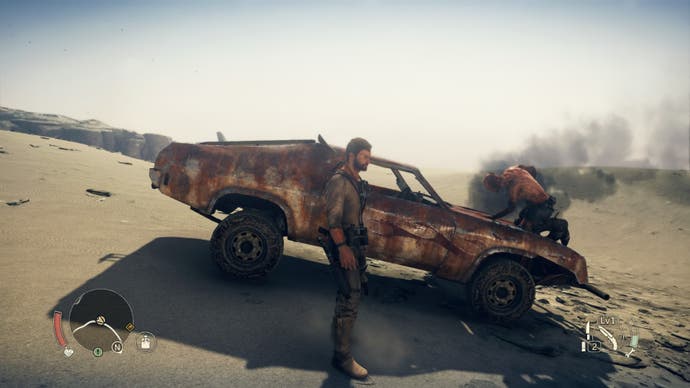
Where Mad Max comes into its own is out on the open road. Avalanche proved with the playgrounds of Just Cause that it excels at dizzying scale, a feeling that's been buffed by the picturesque expanses of Mad Max's wastelands, where detail and scope combine to create a real sense of dry-throated atmosphere. Dust devils whirl across dunes and sand sweeps across tired asphalt, while the skyboxes sell the post-apocalyptic drama better than any other element, from their milky blue beauty through to more menacing hues.
It's the storms that come rolling in across Mad Max's wastelands that are its trump card. Walls of angry cloud creep up on the player - echoing one of Fury Road's most stirring set-pieces - consuming them in dervishes of lightning strikes and flying debris. If you're in a camp you're enshrouded by a moody hostility, while if you're out in the open world you're unable to step out of your car, lest you be torn to shreds by the thundering chaos. This is Mad Max at its best: a world of twisted metal and sudden violence that's there to be survived rather than conquered.
Such elements bleed into the heart of Mad Max, which is ultimately a scrappy hymn to the automobile - and to a particular, snarling and very primitive take on the automobile. This is just as much the tale of the Magnum Opus, the car you construct and upgrade throughout the course of the story, as it is of Max, and it's where most of the effort seems to have been spent. The vehicles here are fighty, spongy things, their fat tires bouncing through sand while their beaten panels scrape against each other, and the Magnum Opus is brilliantly moddable too. You can add wheel rims that chew up other cars, spikes that stop enemies from boarding and side burners that can spit out fierce jets of flame. When other cars inevitably detonate, you can sense a little more of that Avalanche magic from Just Cause in the billowing, bright explosions that ensue.
The chaos of previous Avalanche games is a little more muted here, although it's undeniably present. The Magnum Opus has a harpoon that feels like a distant cousin of Just Cause's grapple gun, being used to tug away at control towers and to whip wheels off of sparring cars in combat that's pleasingly physical. It's capable of some great slapstick, too, yanking drivers out from behind the wheel and dragging them across the coarse sand before they're unceremoniously hurled across the scenery.
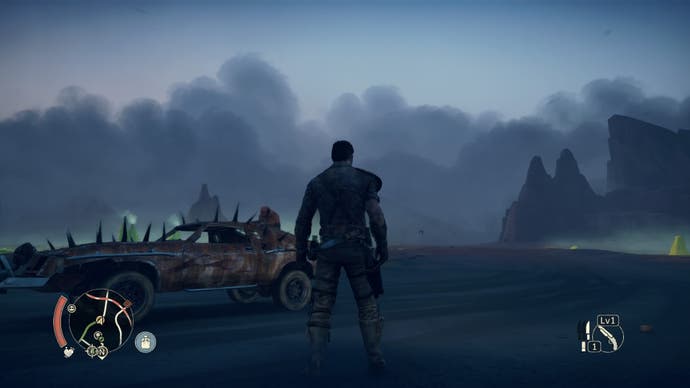
When Mad Max brings all of its best elements together, it's brilliant. Scan the horizons and spot the plume of dust that's the telltale sign of a convoy passing through, then open up that breathy V8 to gobble up the scenery that's between you. Get in the fray and feel where the influence of Miller's kinetic action has rubbed off as cars tear themselves to shreds while you're taking potshots at fuel-tanks with a sawn-off shotgun. The choreographed ballet of the films might be lost in all that noise - as too is some of that original Ballardian subtext - but the energy and the spectacle remains intact.
Take all that away, and you're left with a rote open-world game that's not without its problems. Objectives soon repeat themselves a little too often, while oversights remain in much of the design: despite being a car combat game, there's no handbrake and no way to get the cars spinning on their axis in true Hollywood fashion, while the combat feels too scrappy for its own good. The sense of being a scavenger can become overwhelming, too, when progression grinds to a halt and you're left patrolling the wastelands searching for scraps.
That ties neatly into the harsh world of Mad Max, though, as does the slightly cultish feel of a game whose rough edges might scare some people away. You'll have played other, better examples of the genre, and you've likely been a tourist to the post-apocalypse a few too many times before, yet Avalanche wears the fiction so well it's hard not to be charmed by this brutal, beautiful open world.
